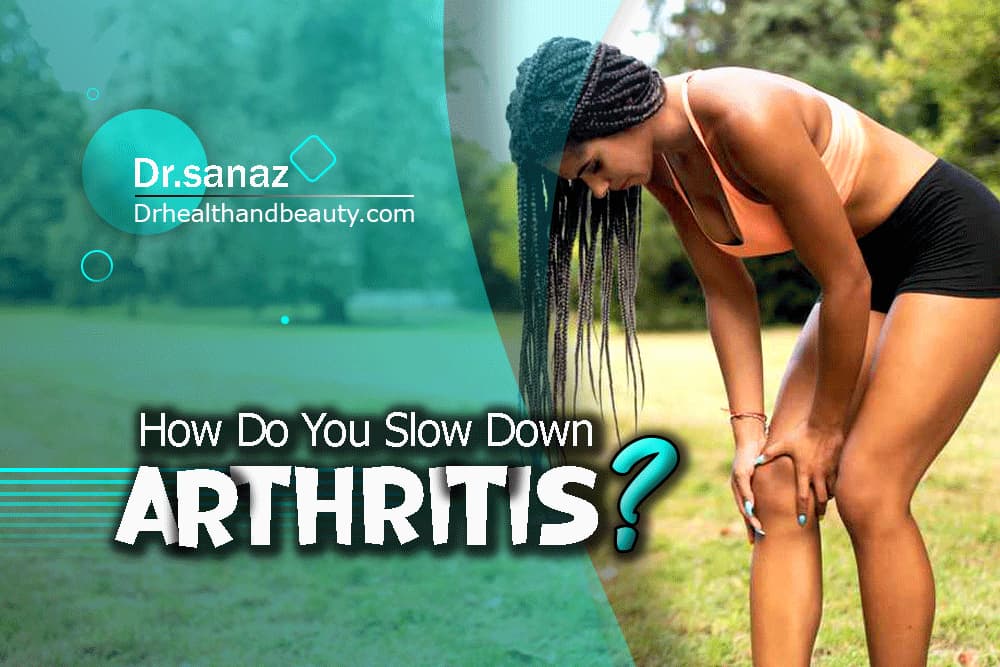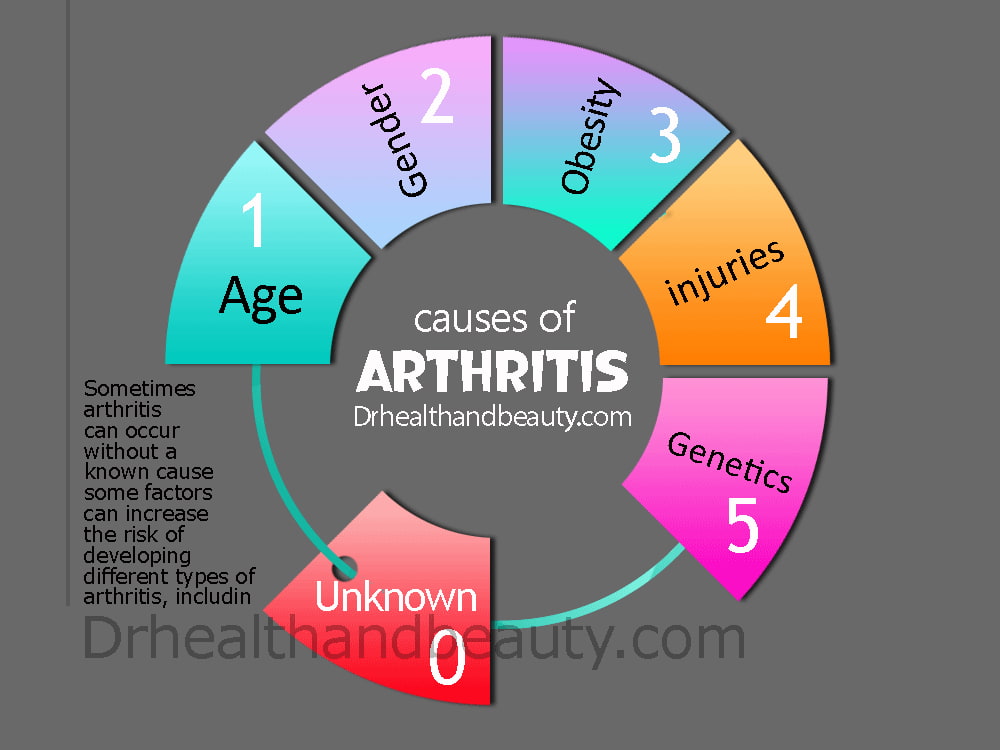

How Do You Slow Down Arthritis?
Table of Contents
Introduction
Arthritis is not a disease. It is a group of painful and degenerative conditions with inflammation in the joints that causes hardness, pain, and reduced range of motion in the joint.
There are more than 100 different types of arthritis. The most crucial symptom of arthritis is joint pain and stiffness that worsens with age.
Arthritis leads to cartilage thinning, making your joints bend and move slowly. This thinning causes bone-on-bone friction, swelling, and pain. You may find it challenging to get up from a sitting position, climb stairs, open a window, or raise your arms above your shoulders.
In this article from drhealthandbeauty by Dr. Sanaz, we will examine and explain the methods of slowing down arthritis pain and we will explain whether arthritis can be completely cured?

Common types of arthritis
The two main species of arthritis are rheumatoid arthritis and osteoarthritis.
- Osteoarthritis is the most common type of arthritis. It worsens with age and is caused by the wear and tear of shock-absorbing cartilage caused by injury over time.
- Rheumatoid arthritis is an autoimmune illness in which the body’s immune system offensive the joints as foreign tissues.
.
The cause of rheumatoid arthritis is not known. However, it seems that risk factors, including genetic factors such as a family history of rheumatoid arthritis and environmental factors such as smoking, gum disease, and obesity, play a role in developing this condition.
Early diagnosis and appropriate treatment reduce and eliminate symptoms, prevent or delay joint damage, and help patients with arthritis live an active life.
Related: “Shocking But Hopeful / Can Autoimmune Disease Kill You?“

Arthritis is more painful than paralysis!
What happens to your body when you have arthritis?
Joint inflammation in arthritis can destroy cartilage and bone and change the shape of the joints. As the disorder progresses, it destroys most of the joints, and that part of the body reduces and loses its efficiency significantly.
Arthritis causes the loss of cartilage and bone and changes the shape of the joints.
Apart from the joints, arthritis can also affect other body parts. These members are:
- Rheumatoid nodules are hard masses that occur under the skin and internal organs.
- Sjögren’s syndrome: inflammation and damage to the glands of the eyes and mouth
- Pleuritis: inflammation of the lung mucosa
- Pericarditis: inflammation of the lining around the heart
- Anemia: reduction of red blood cells
- Felty syndrome: A decrease in white blood cells associated with an enlarged spleen
- Vasculitis: inflammation of blood vessels that can disrupt blood flow to tissues.
Physical complications of arthritis
Arthritis has many physical and social aftereffects and can reduce a person’s quality of life. This disease can cause pain, inefficiency, and premature death.
In the following, we give a brief explanation of the two main complications of arthritis:
premature heart disease
People with arthritis are more likely to suffer from chronic diseases like heart disease and diabetes. To prevent heart disease in these patients, their treatment process is followed so that the risk factors of heart disease are reduced for them. For example, one of the doctors’ recommendations to patients is to reduce their weight and quit smoking.
obesity
Obese people with arthritis are more likely to suffer from heart disease risk factors such as high blood pressure and cholesterol. Of course, obesity also increases the risk of chronic diseases like heart disease or diabetes. Finally, the drug’s effect on obese people is less than on non-obese people.
Related: “Best Pills To Reduce Cholesterol“

At what age does arthritis usually start?
Genetics, age, gender and smoking addiction are among the risk factors of arthritis.
The incidence of this complication is very low. For example, it includes 1% of the population of the United States. Arthritis usually appears between the ages of 30-60, but that doesn’t mean people under 30 or over 60 are immune.
This disorder occurs two to three times more in women than in men. Other things that increase the risk of this disorder are smoking or the presence of this disorder in the family.
Juvenile arthritis (JRA) is a sporadic form of this disorder. Like adult arthritis, this disorder also causes joint inflammation, stiffness, and damage. It can also cause problems in adolescent development. Juvenile rheumatoid arthritis is idiopathic arthritis, which means idiopathic is unknown.

Arthritis with or without reason!
What are the common causes of arthritis?
Sometimes arthritis can occur without a known cause. However, some factors can increase the risk of developing different types of arthritis, including:
- Age. Increasing age increases the risk of developing species of arthritis like gout, osteoarthritis, and rheumatoid arthritis in people.
.
- Family history. If your parents or siblings have this type of arthritis, you are more likely to develop arthritis.
.
- Gender: Women are more presumably to develop rheumatoid arthritis than men, while men are more presumably to develop gout.
.
- Obesity Being overweight can increase a person’s risk of developing osteoarthritis because it puts more pressure on the joints.
.
- History of previous injuries. Those who have injured a joint from sports, a car accident, or other causes are more likely to experience arthritis later.
.
Even if you do not feel symptoms, you should discuss your possible risks for arthritis with your doctor. They can help provide ways to prevent and reduce or delay arthritis.

How do you slow down arthritis?
The important thing to pay attention to is that Arthritis cannot always be prevented. Some causes, such as age, family history, and gender, are beyond your control.
However, following a few healthy customs can help reduce your risk of expanding painful joints as you age. Many strategies, such as exercise and eating a healthy diet, help prevent and reduce other diseases. Ask a doctor what type of exercise is best for your fitness level.
If you have not exercised, start slowly and only gradually increase the intensity when you feel ready. You might walk for 10 minutes the first day, then increase to 15 minutes until you can walk for 30 minutes. Ask a physical therapist or athletic trainer to teach you these exercises.
To slow down arthritis:
Manage your weight to slow down arthritis.
Your knees should support your body weight. Being overweight or obese can seriously harm them. If you are only 10 pounds overweight, the force on your knee increases by 30 to 60 pounds with each step you take.
People who are overweight are up to 4.55 times more likely to expand knee osteoarthritis than people with average weight. Obesity is related to a higher risk of rheumatoid arthritis and psoriatic arthritis. Diet and exercise can help you get your weight into a healthier range. If you are having trouble losing weight, cognitive-behavioral therapy may help.
In that regard, reading the article”Diet And Exercise Plan For Obese Men” would be worthwhile.

Take omega 3 to slow down arthritis.
Omega 3 fatty acids are a type of unsaturated fat. They have benefits, including reducing inflammation in the body. Research has also shown that omega-3 reduces the activity of rheumatoid arthritis in the joints.
Fish such as salmon, trout, or sardines are rich in omega-3. Wild-caught fish are usually preferred over farmed fish.
If you are a vegetarian, non-fish source of omega-3, include:
- Nuts equal walnuts and seeds like flax seeds to slow down arthritis
- Vegetable oils like soybean oil and canola oil, and flaxseed oil
- Eggs, fortified juices, and drinks containing soy

Exercise to slow down arthritis
Exercising removes stress from your joints due to excess weight and strengthens the muscles around the joints. This stabilizes them and can protect them from wear. Types of exercise can be divided into four categories, and it is essential to try to do all four types. These exercises include:What exercises beat arthritis?
Endurance or aerobic exercises to slow down
This exercise, which includes walking, swimming, and cycling, strengthens your heart and increases endurance. It improves your overall fitness and can help reduce excess fat that may strain your joints more. Try to do 30 minutes of aerobic sports five days a week.
.
Strength training to slow down arthritis
Lifting weights, using elastic resistance bands, or working against your body weight will strengthen the muscles that support the joints. Have at least two 20-30 minute strength training sessions a week. Try to do 8-10 repetitions of each exercise with weights or 10-15 repetitions without weights or lighter weights.

Flexibility exercises to slow down arthritis
Stretching, yoga, and pilates move your joints through their full range of motion, preventing stiffness and reducing the risk of injury. Stretch at least 4-5 days a week and hold each stretch for 10-15 seconds. You can stretch at the end of your workout or when you wake up.
.
Balance exercises
Tai Chi, balancing on one leg, or walking from heel to toe are exercises that improve your balance and posture. These exercises can also help prevent falls if your foot joints are shaky. Add balance exercises to your schedule a few times a week.

Protect your joints to slow down arthritis.
Lifting heavy objects, squatting, and climbing stairs can lead to joint problems. Lifting can be especially painful for the joints.
Studies have shown that workers who constantly have to lift heavy objects and squat, kneel or climb stairs are more than five times more likely to develop knee osteoarthritis than workers who do not lift heavy objects. Using proper techniques when sitting and lifting can help protect your joints from everyday stress.
For example, lift on your knees and hips – not your back when picking up objects. Carry things close to your body so you do not put too much pressure on your wrists.
You may also be interested in reading the article “What Are The Risk Factor For Spondyloarthritis?“
Treat any infection to slow down arthritis.
Some bacteria and viruses can infect your joints and cause arthritis. Infectious arthritis, or septic arthritis, is a painful form of joint disease caused by bacteria such as Staphylococcus aureus (staph).
Usually, these bacteria enter the bloodstream and travel to the joint or the fluid around the joint. This type of arthritis can be treated with antibiotics.
A study found that respiratory infections like colds and flu may also cause rheumatoid arthritis. The infection may trigger an abnormal immune system response that causes the autoimmune disease.
You can find valuable information in “Contagious Bronchitis Spreads Faster Than Coronavirus! “
Take care of your blood sugar to slow down arthritis
The relationship between arthritis and diabetes is bidirectional. So that people with arthritis are 61% more at risk of diabetes.
A survey in 2019 showed that People with type 2 diabetes are more similar to develop osteoarthritis, even if they are not overweight.
This is because high blood sugar may lead to constant inflammation with Down degrees in the body.
It also contributes to creating reactive oxygen species (ROS) – ( substances that help to produce inflammatory proteins called cytokines in the joints. )
Regular blood sugar and diabetes treatment to prevent complications such as nerve and eye damage is essential. There is also evidence that diabetes can be treated by slowing down arthritis.

Maintain the ergonomics of your body
Maintain the ergonomics of your body to slow down arthritis.
Adjusting the ergonomics of the body can prevent pressure and pain in joints that are already painful.
- If you sit long at work, ensure your back, legs, and arms are in good posture.
- Keep your computer monitor at arm’s length from you and about 15 degrees below your line of sight at work.
- Avoid putting pressure on your neck. Use an ergonomic keyboard and mouse.
- Keep your arms and hands in a neutral position. Select An office chair with good back and back support.
- Resorts and Sit with your back straight and place your feet on the floor or a footstool.
- Adjust your arms so that your arms are at a 90-degree angle also wrists are straight.

Quit smoking to slow down arthritis.
Quitting this habit can be difficult. However, quitting smoking not only reduces the risk of heart and lung diseases However, it also helps protect against arthritis. During a study, researchers found that:
- Men who smoke are twice as likely to develop rheumatoid arthritis as non-smokers.
- Smoking women were about 1.3 times more likely to develop rheumatoid arthritis than non-smoking women. Researchers believe that the increase the risk may be because rheumatoid arthritis affects how the immune system works.
- Rheumatoid arthritis is an inflammatory disease, and smoking increases inflammation.
- Smoking can also affect the outcome of your treatment.

Foods that relieve arthritis pain
Recent studies by the Arthritis Foundation of America show that healthy foods, including whole grains, fresh fruits and vegetables, and nuts, can reduce inflammation and pain caused by arthritis. On the other hand, the continuation of these studies shows that weight directly affects the severity of arthritis. Each pound of weight loss (equivalent to 0.45 kg) reduces the extra load pressure on the knee by about 4 pounds.
Therefore, losing weight and achieving a balanced size is crucial to reducing pain caused by arthritis and arthritis. Some foods that reduce pain and inflammation caused by arthritis are:
- Broccoli, Brussels, and cabbage leaves and flowers
- Fatty fish
- garlic
- Cherry
- Turmeric
- Vitamin C
- Ginger
- Walnut
- Spinach

Is arthritis completely curable?
Arthritis is a complex group of musculoskeletal disorders for which there is no cure.
You should know that all the treatments and strategies offered are for symptom management, improving joint function, and preventing its condition from worsening.
All the treatment strategies provided by the researchers are actually an attempt to effectively control the symptoms of arthritis, which can slow down the development of the disorder and improve the quality of life of people suffering from this illness.
However, you should not forget that early diagnosis and proper treatment will be very important and key in the effective management of arthritis and preventing further joint damage.
.
Conclusion
Arthritis means joint inflammation, osteoarthritis is usually caused by wear and tear, while rheumatoid arthritis is an autoimmune disorder.
Uric acid crystals, infections, and underlying diseases such as psoriasis or lupus can cause another kind of arthritis. Treatment depends on the type of arthritis. One of the main goals of arthritis treatment is to reduce symptoms and improve the patient’s quality of life.


